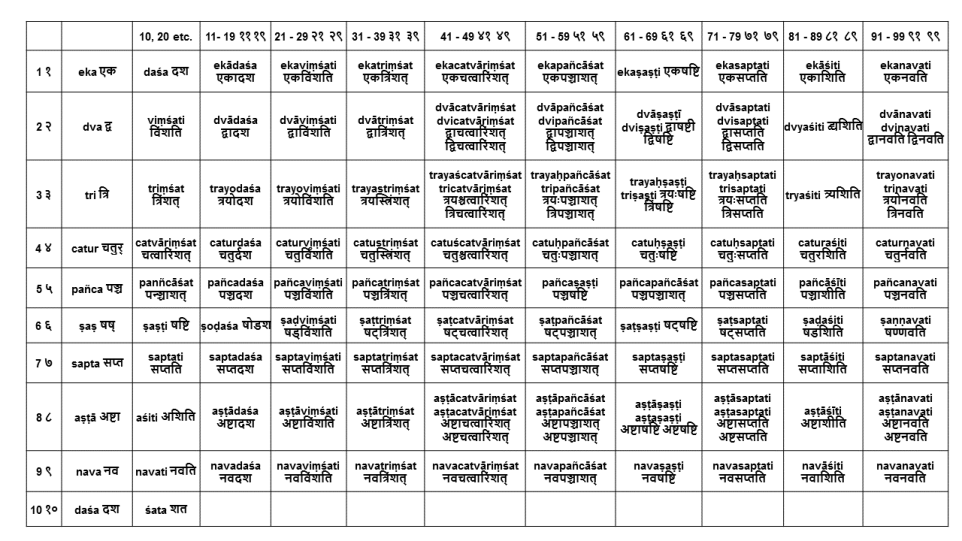
Declension of numerals
The first four cardinal numerals distinguish gender.
eka एक is declined like pronominal adjectives like sarva सर्व
dva द्व is declined as follows (only in dual): nom-acc-voc dvau द्वौ (masc.) dve द्वे (feminine neuter) instr-dat-abl dvābhYam द्वाभम् genitive-locative dvayoḥ द्वयोः
tri त्रि is declined as follows (only in plural): masculine trayaḥ trīn tribhiḥ tribhyaḥ tribhyaḥ trayāṇām triṣu त्रयः त्रीन् त्रिभिः त्रिभ्यः त्रिभ्यः त्रयाणाम् त्रिषु; feminine tisraḥ tisraḥ tisr̥bhiḥ risr̥bhyaḥ trisr̥bhyaḥ trisr̥ṇām tisr̥ṣu tisraḥ tisraḥ tisr̥bhiḥ tisr̥bhyaḥ tisr̥bhyaḥ tisr̥ṇām tisr̥ṣu तिस्रः तिस्रः तिसृभिः तिसृभ्यः तिसृभ्यः तिसृणाम् तिसृषु; neuter trīṇi trīṇi tribhiḥ tribhyaḥ tribhyaḥ trayāṇām triṣu त्रीणि त्रीणि त्रिभिः त्रिभ्यः त्रिभ्यः त्रयाणाम् त्रिषु
catur चतुर् is declined as follows: masculine catvāraḥ caturaḥ caturbhiḥ caturbhyaḥ caturbhyaḥ caturṇām caturṣu चत्वारः चतुरः चतुर्भिः चतुर्भ्यः चतुर्भ्यः चतुर्णाम् चतुर्षु; feminine catasraḥ catasraḥ catasr̥bhiḥ catasr̥bhyaḥ catasr̥bhyaḥ catasr̥ṇām catasr̥ṣu चतस्रः चतस्रः चतसृभिः चतसृभ्यः चतसृभ्यः चतसृणाम् चतसृषु; neuter catvāri catvāri caturbhiḥ caturbhyaḥ caturbhyaḥ caturṇām caturṣu चत्वारि चत्वारि चतुर्भिः चतुर्भ्यः चतुर्भ्यः चतुर्णाम् चतुर्षु
Numbers 5 to 19 have to distinction of gender
pañca pañca pañcabhiḥ pañcabhyaḥ pañcabhyaḥ pañcānām pañcasu पञ्च पञ्च पञ्चभिः पञ्चभ्यः पञ्चभ्यः पञ्चानाम् पञ्चसु
ṣaṭ ṣaṭ ṣaḍbhiḥ ṣaḍbhyaḥ ṣaḍbhyaḥ ṣaṇṇām ṣaṭsu षट् षट् षड्भिः षड्भ्यः षड्भ्यः षण्णाम् षट्सु
aṣṭa – aṣṭau aṣṭa – aṣṭau aṣṭābhiḥ – aṣṭabhiḥ aṣṭābhyaḥ – aṣṭabhyaḥ aṣṭābhyaḥ – aṣṭabhyaḥ aṣṭānām aṣṭāsu – aṣṭasu अष्ट – अष्टौ अष्ट – अष्टौ अष्टाभिः – अष्टभिः अष्टाभ्यः – अष्टभ्यः अष्टाभ्यः – अष्टभ्यः अष्टानाम् अष्टासु – अष्टसु
sapta सप्त, nava नव daśa दश and 11 to 19 are declined like pañca पञ्च
The tens and their compounds from 20 up to 99 are declined like feminine stems of the same endings.
100 and above are declined like neuters of the same endings.
Ordinals
1 – prathama प्रथम, ādya आद्य and ādima आदिम
2 – dvitīya द्वितीय
3 – tr̥tīya तृतीय
4 – caturtha चतुर्थ, turīya तुरीय, turya तुर्य
5- pañcama पञ्चम
6 – ṣaṣṭha षष्ठ
7, 8, 9 and 10 add “ma म” like 5.
11th to 19th are the same as the cardinals,
20th upwards: the cardinal is made either by adding “tama तम” to the cardinal or in “a अ” with abbreviation of the cardinal viṃśa triṃśa catvāriṃśa pañcāśa ṣaṣṭa saptata aśita navata विंश त्रिंश चत्वारिंश पञ्चाश षष्ट सप्तत अशित नवत and similarly ekaviṃśa catustriṃśa एकविंश चतुस्त्रिंश etc.
śata sahasra शत सहस्र make with “tama तम” only – śatatama sahasratama शततम सहस्रतम but their compounds like the numbers above twenty have both forms.
Feminines of ordinals
The feminines of prathama प्रथम, ādya आद्य, ādima आदिम, dvitīya द्वितीय, tr̥tīya तृतीय, turīya तुरीय, turya तुर्य are made with “ā आ” and the others with “ī ई”
Declension of ordinals
They are declined like adjectives of the same endings